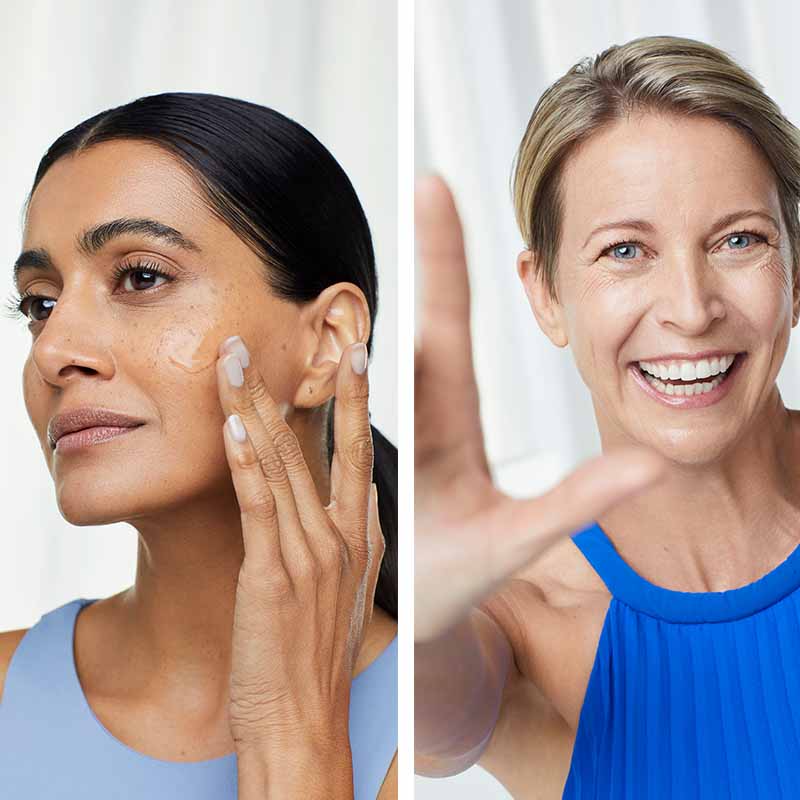Ready to discover everything you could ever want to know about hyaluronic acid? Then take a peek at this handy post. Featuring the most common questions (and answers) people have when it comes to this amazing skincare ingredient.
So, what is hyaluronic acid and why’s it important?
Right, let’s get back to basics. Hyaluronic acid is a molecule that’s already found naturally within the human body, including all three layers of the skin. As we age, our body’s hyaluronic acid levels decrease big time, resulting in those pesky fine dehydration lines that can make us panic-buy ALL the anti-ageing treatments! But it’s not all bad news. Regular use of a hyaluronic acid cream can reintroduce higher levels back into the skin, which will then help to plump up those fine lines for a younger-looking complexion.
What’s hyaluronic acid made from?
Known as the ‘goo’ molecule until the late 1970s, hyaluronic acid is a viscous substance that’s produced naturally by your body. Often found in the eyes, joints and skin, it’s essentially a moisture-rich super ingredient that works to lubricate and hydrate.
How many types of hyaluronic acid are there?
There are 3 different types of hyaluronic acid:
- Hydrolysed hyaluronic acid
- Sodium acetylated hyaluronate
- Sodium hyaluronate
One of the key differences between the 3 is that sodium hyaluronate has a smaller molecular size, and so it’s absorbed faster by your skin. Not only that, it’s also able to hold 1000x its own weight in water. That’s why it’s such a beauty hero, especially when it comes to anti-ageing skincare.
@avon_uk You’re gonna want our new Hydrate & Plump Concentrate with 3.5% Hyaluronic Acid Complex 💦 #skincaretips #hydratingskincare #serum #affordableskincare ♬ original sound - Beat Cactus Customs
Hyaluronic acid uses for skin
From hyaluronic acid serums and face creams to cleansers and even face masks, there are so many benefits to introducing hyaluronic acid to your skincare routine.
What does hyaluronic acid do to the face?
Like I’ve already said, the molecules within hyaluronic acid work like little super-juicy sponges holding up to 1000x their own weight in water. So, when they’re applied to your skin, they flood your complexion with instant hydration and moisture. This makes it the dream ingredient for when your skin feels dehydrated or tight.
What are the benefits of hyaluronic acid for skin?
Tired of waking up to dehydrated, tired-looking skin with crepey fine lines? Then it’s time to treat yourself to the many benefits of hyaluronic acid. Overtime, its hydrating qualities help to plump, smooth and brighten – basically, everything you could ever want from a skincare ingredient! Just think how amazing (and smug) you feel after drinking lots of water. That’s just how your skin feels.
Looking for the best hyaluronic acid serums for seriously thirsty skin?
For longer-lasting plumpness, apply a serum infused with around 3.5% of hyaluronic acid. This will quench your skin’s thirst by delivering an instant hit of much-needed hydration. After cleansing with a hyaluronic cleanser, I love to apply it alongside a hyaluronic moisturiser for a double whammy of hydration. Layering your skincare is a great way to achieve a healthier look. Thirsty skin be gone!
In need of some serious beauty sleep?
Nighttime is when your skin is at its most vulnerable to dehydration. Just think about how thirsty you feel first thing? To keep that dry feeling at bay (and those wrinkles) try using a hyaluronic acid Overnight Mask. Rich and creamy, it drenches your skin so you wake up with a plumper, more hydrated complexion.

Can I use hyaluronic acid around my eyes?
Thankfully, yes, the skincare gods have answered our prayers. The delicate area around your eyes is often prone to dehydration, fine lines and that dreaded crepey feeling. Luckily, hyaluronic eye creams and gels are designed to help to restore and re-plump.
First thing’s first, apply your eye cream
To quote Caroline Hirons, “applying your eye product last is like wearing your knickers over your trousers.” So, before beginning your morning/evening routine, start by dabbing a pea-size amount of your go-to eye cream and pat it into the skin under your eyes, across your eyelids and over your brow bone. For best results, leave it a minute or two to fully absorb and finish by applying your go-to serum or face cream.
Can lips absorb hyaluronic acid?
Just like the skin around your eyes, lips can also benefit from a little hyaluronic TLC. Whether your lips struggle in the winter when it’s icy cold, or in the summer with the dehydrating heat and aircon, a lipstick or lip balm infused with hyaluronic acid is a must. Why? Its hydrating and plumping qualities work perfectly to fill in cracked, dry lips for a fuller, healthier look. Sign me up!
Is hyaluronic acid good in lipstick?
Short answer? YES! Lipsticks infused with hyaluronic acid not only look amazing they feel amazing too. Our Hydramatic Matte Lipstick delivers bold, matte colour alongside an instant hit of hydration. Unlike your usual matte lipsticks, it glides on smoothly without dragging your lips and dries softly without that flaky finish. What more could you want from a lipstick?

@avon_uk @Gemma wears shades Mauve, Rosy, and Flame 🔥 of new #HydramaticMatteLipstick #hydratingmatte #lipstickswatching #lipstickreview #lipsticktryon #makeuptips #avon ♬ original sound - AvonUkOfficial
Want silky-soft strands? Let’s face it, who doesn’t? Step right this way!
Is hyaluronic acid good for your hair?
The hype around hyaluronic acid for your hair is real. All those benefits you see in your skincare routine, you bet they show up in your haircare routine as well. How we hear you ask? Hyaluronic acid draws moisture to your scalp, boosting hydration and leaving you with shinier-looking, softer-feeling hair. Lab coats on – let’s take a closer look at the benefits.
Hello, hydration
The binding properties work similarly in skincare as it does haircare – allowing the fibres to retain all that precious moisture from shampoos, conditioners and treatments.
Bye-bye frizz
Hyaluronic acid helps seal hair cuticles, which gets rid of unwanted moisture that causes frizzy strands. So, if you’re looking forward to a holiday in a humid destination, make sure you pack some hyaluronic haircare to keep that frizz under control.
How do I use hyaluronic acid on my hair?
Sun, styling and heat can leave your hair looking and feeling a bit “meh”. From shampoos and conditioners to serums and leave-in treatments, getting a hit of hyaluronic hydration in your hair routine couldn’t be easier! And because hyaluronic acid is super lightweight (you know all about that now), it’s great for all hair types – including those of us with thinner or finer hair.
Use it as a pre-shampoo treatment
Got your hyaluronic acid serum to hand? Apply 5-6 drops liberally over your scalp, massaging it in with your fingertips.
Use it on a wet or damp hair
Your hair is most receptive when it’s wet, so applying the magic of hyaluronic acid while your strands are still wet is a great way to secure softer-feeling, shinier-looking locks.
Use it as a leave-in conditioner
Nothing beats a freshly conditioned head of hair, so why not use hyaluronic acid in place of your usual leave-in conditioner? Apply it from root to tip, comb through and then layer your preferred styling product on top. Easy peasy.
Pssst! If you’re looking for an easy way to revive your lacklustre locks, treat yourself to our Advance Techniques Hydra Boost Shampoo – packed with our new favourite.

Quick tips
How to use hyaluronic acid in your routine
As with most skincare products, it’s best to use hyaluronic acid consistently to see the best results. As a rule of thumb, you’ll want to apply a pea sized amount to damp skin after cleansing. Remember to lock in all that hydrating goodness with a moisturiser and face oil.
When to use hyaluronic acid serum in your routine
You should apply your hyaluronic acid serum after your eye cream and before your moisturiser. This should be the same for both your day and night skincare routines. To reap the benefits, give it a couple of minutes before applying your moisturiser so the serum is fully absorbed.
How much hyaluronic acid serum should you use?
Morning and night, squeeze a couple of drops of your favourite serum into your hands and gently massage onto your face. As we said, to really see the benefits of this hydrating, moisture-rich serum, make sure you apply regularly.
Is it OK to use hyaluronic acid every day?
It absolutely is, so smooth it on a clean face morning, noon and night! And if you’re a die-hard vitamin C fan, hyaluronic acid is the perfect partner for repairing and protecting skin – win, win.
Although “acid” is in the title, don’t be fooled, it’s the opposite of skincare acids like glycolic, lactic or salicylic. Basically, it won’t exfoliate dead skin cells.
When should I use hyaluronic acid?
While it’s a fab year-round ingredient, it's also one to lean on during the winter months, when the cold weather outside and central heating inside sucks the moisture out of your skin.
Time to treat yourself to hyaluronic acid?
And there you have it, the A-Z of your new favourite ingredient. Moisture-rich and wrinkle-plumping, it’s one of my favourites. So, go forth and bask in your new H20 hit – no need to thank me.


